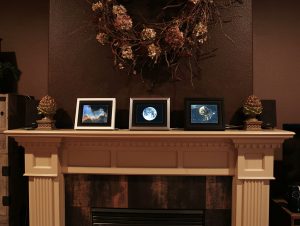Backlit prints for astrophotography are available from Wa-chur-ed Observatory in a number of sizes.
As Greg Marshall, owner of Wa-chur-ed Observatory, notes: “Images printed on paper can never have a contrast ratio of more than 100:1, while our eyes can handle ratios of 10,000:1 or more (the exact number is difficult to define or measure). Printing an image on transparency film provides a contrast range of almost 1,000:1 – not as good as the eye, but a huge improvement over paper prints. This is especially important for astro-photos because they inherently have very high contrast ratios – from the blackness of empty space to very bright stars. But it can also enhance the appearance of nearly any image.”
 Each frame comes with a small AC adapter. Because the light source is LED and the design is very efficient, relatively little power is needed (ranging from 1 to 8 watts). A sheet of special acrylic material is lit along the edges of the frame by a strip of closely spaced, white LEDs, forming a “light box”. The light is evenly distributed through the material and eventually bounces off a white backing and through the film. Both the light box and film (plus a mat and glass cover sheet) are assembled into a conventional photo frame (either wood or aluminum).
Each frame comes with a small AC adapter. Because the light source is LED and the design is very efficient, relatively little power is needed (ranging from 1 to 8 watts). A sheet of special acrylic material is lit along the edges of the frame by a strip of closely spaced, white LEDs, forming a “light box”. The light is evenly distributed through the material and eventually bounces off a white backing and through the film. Both the light box and film (plus a mat and glass cover sheet) are assembled into a conventional photo frame (either wood or aluminum).
The film itself is essentially a giant version of a 35mm slide. It is printed on a machine that uses sweeping laser beams to expose the film with more than 1200 pixels per inch. Most places that offer film prints can do only 200 to 400 pixels per inch. Note that each pixel is a full 24 bit color value, unlike an inkjet or laser printer, which can only create a pattern of dots. The film is then processed in traditional “wet” chemistry.
As Greg notes, “Optimizing an image for display as a backlit print is not a trivial task. I have made more than 100 such prints and know how to get the desired results from the printer. To maintain this quality control, I do not offer “empty” frames or recommend any other printing service.”
The standard 8 x 10 frame is wood and comes in black, white, or silver. It can be either desktop or wall-hung. Other sizes are aluminum frames and are for wall hanging only. The standard color is a matte silver, although other colors are available on special order. A 5 x 7 in. image in an 8 x 10 in. frame is $74US. A 12 x 18 in. image in 16 x 20 in. frame is $279US.
Many other sizes are possible, but generally cost somewhat more per square inch due to the higher cost of purchased materials and labor. The largest size possible is about 19 x 30 inches. The largest Greg has made to date is a 19 x 25 inch image in a 26 x 32 inch frame.
Backlit film prints need a transparent cover to protect the film (it is even more susceptible to fingerprints and such than a paper print). For the 8 × 10 size this is not a big problem – Greg has shipped have shipped dozens of them across the country without breakage. But for the 16 × 20 and larger sizes there is a high risk of glass breaking. And the broken glass would very likely damage the film print as well. He instead can use a clear plastic cover which makes it very simple and straightforward, but there are significant disadvantages: The plastic is easily scratched, more likely to attract dust, and costs significantly more than glass.
The other solution is to ship the print with a chipboard cover to protect the film, and have you (or your favorite frame shop) replace the chipboard with glass. It does not require special glass and even if you have a frame shop do it for you, it should be fairly inexpensive, as it is very easy to do.
You can learn more here.
 And to make it easier for you to get the most extensive news, articles and reviews that are only available in the magazine pages of Astronomy Technology Today, we are offering a 1 year magazine subscription for only $6! Or, for an even better deal, we are offering 2 years for only $9. Click here to get these deals which only will be available for a very limited time. You can also check out a free sample issue here.
And to make it easier for you to get the most extensive news, articles and reviews that are only available in the magazine pages of Astronomy Technology Today, we are offering a 1 year magazine subscription for only $6! Or, for an even better deal, we are offering 2 years for only $9. Click here to get these deals which only will be available for a very limited time. You can also check out a free sample issue here.

